Study Skills Essay: Hofstede's Cultural Dimensions and Business
VerifiedAdded on 2020/12/29
|9
|1200
|244
Essay
AI Summary
This essay provides a critical analysis of Hofstede's cultural dimensions, including individualism versus collectivism, uncertainty avoidance, power distance, and masculinity versus femininity, and their implications within the business environment. The essay evaluates the inter-relation of these dimensions, emphasizing their influence on organizational behavior, operational activities, and strategic decision-making. It discusses how cultural values, beliefs, symbols, rituals, and thought processes shape workplace practices. The author supports their position by referencing specific countries and the impact of cultural dimensions on business practices. The essay also offers suggestions for improving the understanding and application of Hofstede's framework, such as providing more examples, connecting dimensions to the business environment, and incorporating training and feedback mechanisms. The conclusion summarizes the usefulness of the article in providing information and details regarding the Hofstede's cultural dimensions, reflecting upon the elements needed to maintain a constructive workplace environment.

STUDY SKILLS FOR HIGHER
EDUCATION
EDUCATION
Paraphrase This Document
Need a fresh take? Get an instant paraphrase of this document with our AI Paraphraser
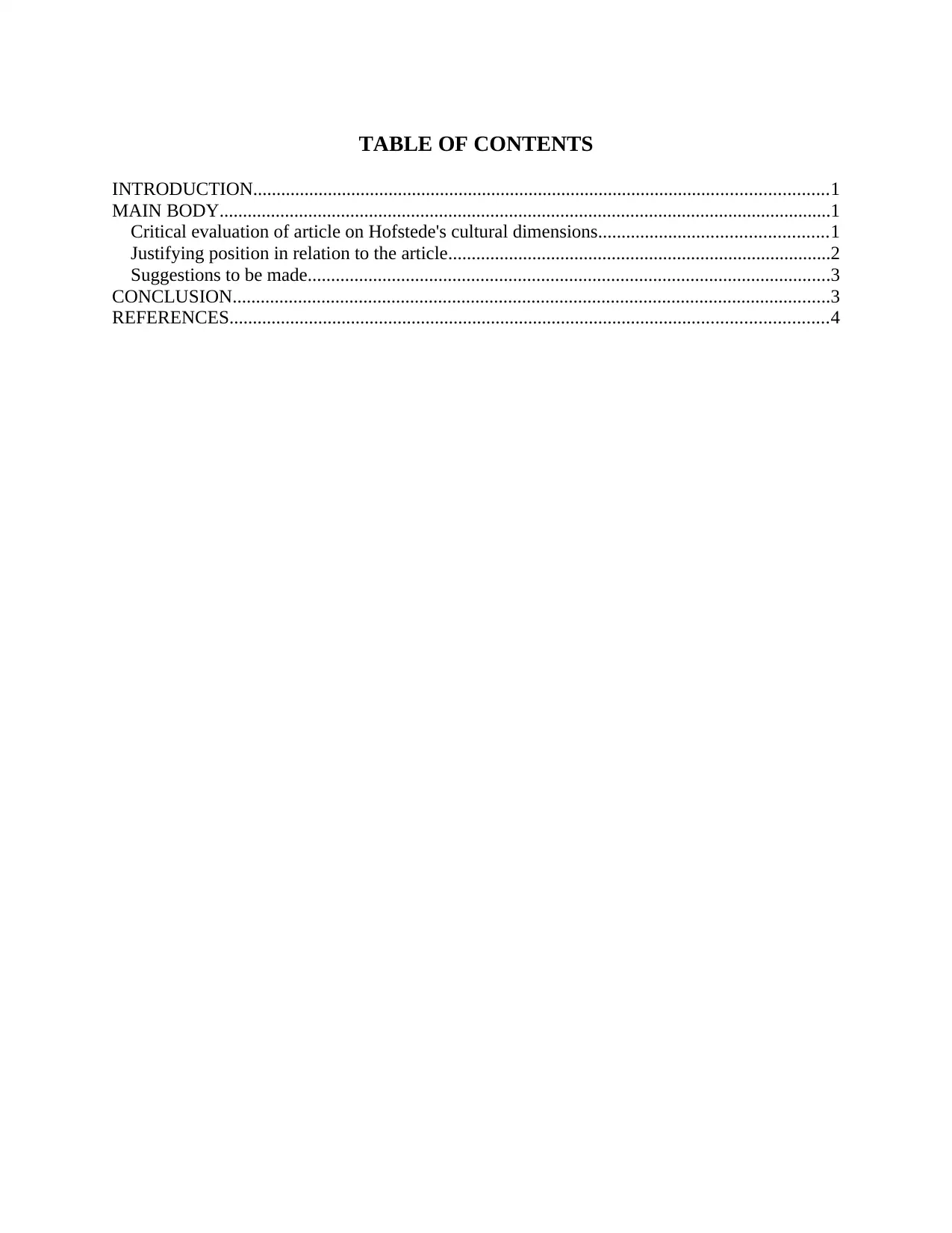
TABLE OF CONTENTS
INTRODUCTION...........................................................................................................................1
MAIN BODY...................................................................................................................................1
Critical evaluation of article on Hofstede's cultural dimensions.................................................1
Justifying position in relation to the article..................................................................................2
Suggestions to be made................................................................................................................3
CONCLUSION................................................................................................................................3
REFERENCES................................................................................................................................4
INTRODUCTION...........................................................................................................................1
MAIN BODY...................................................................................................................................1
Critical evaluation of article on Hofstede's cultural dimensions.................................................1
Justifying position in relation to the article..................................................................................2
Suggestions to be made................................................................................................................3
CONCLUSION................................................................................................................................3
REFERENCES................................................................................................................................4
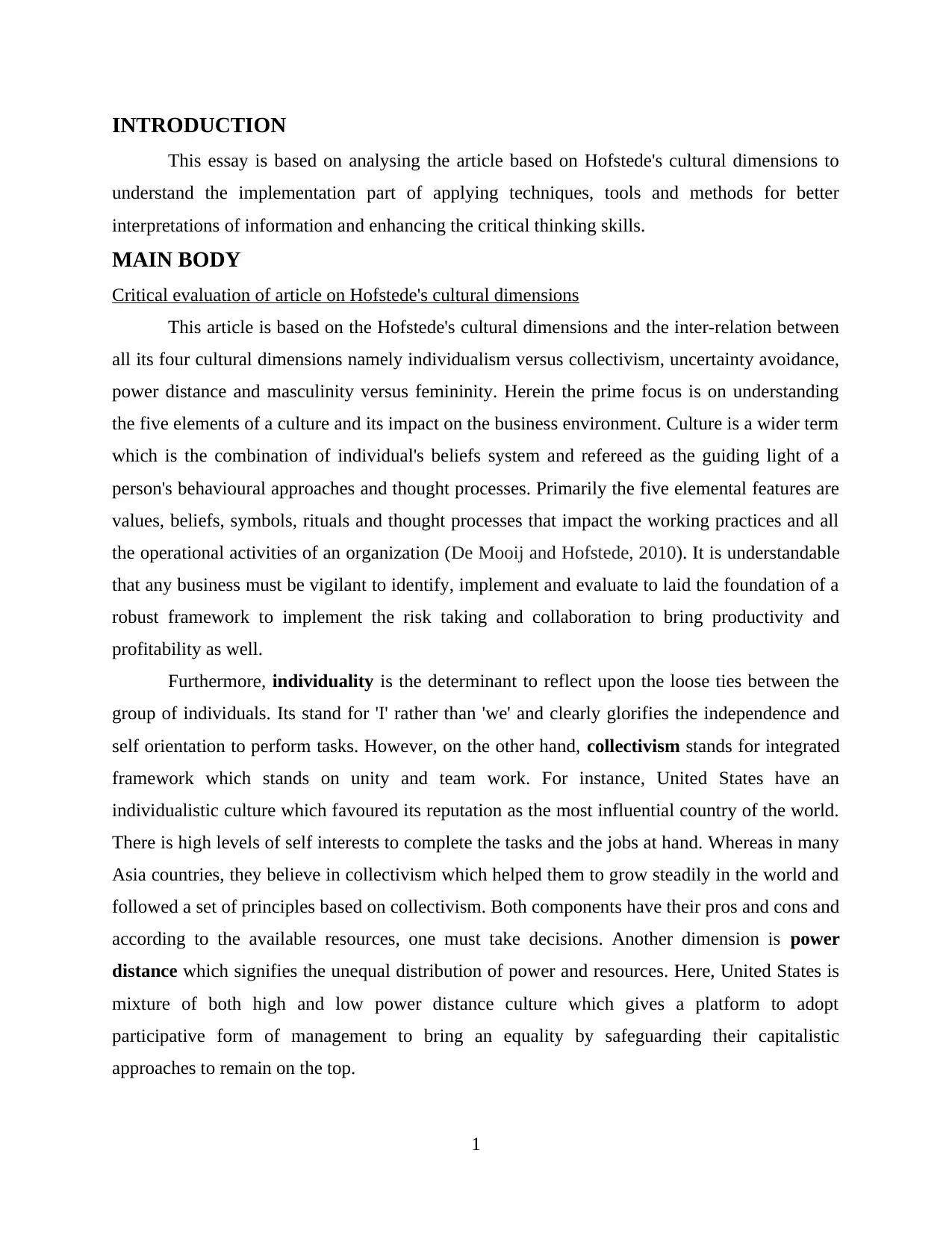
INTRODUCTION
This essay is based on analysing the article based on Hofstede's cultural dimensions to
understand the implementation part of applying techniques, tools and methods for better
interpretations of information and enhancing the critical thinking skills.
MAIN BODY
Critical evaluation of article on Hofstede's cultural dimensions
This article is based on the Hofstede's cultural dimensions and the inter-relation between
all its four cultural dimensions namely individualism versus collectivism, uncertainty avoidance,
power distance and masculinity versus femininity. Herein the prime focus is on understanding
the five elements of a culture and its impact on the business environment. Culture is a wider term
which is the combination of individual's beliefs system and refereed as the guiding light of a
person's behavioural approaches and thought processes. Primarily the five elemental features are
values, beliefs, symbols, rituals and thought processes that impact the working practices and all
the operational activities of an organization (De Mooij and Hofstede, 2010). It is understandable
that any business must be vigilant to identify, implement and evaluate to laid the foundation of a
robust framework to implement the risk taking and collaboration to bring productivity and
profitability as well.
Furthermore, individuality is the determinant to reflect upon the loose ties between the
group of individuals. Its stand for 'I' rather than 'we' and clearly glorifies the independence and
self orientation to perform tasks. However, on the other hand, collectivism stands for integrated
framework which stands on unity and team work. For instance, United States have an
individualistic culture which favoured its reputation as the most influential country of the world.
There is high levels of self interests to complete the tasks and the jobs at hand. Whereas in many
Asia countries, they believe in collectivism which helped them to grow steadily in the world and
followed a set of principles based on collectivism. Both components have their pros and cons and
according to the available resources, one must take decisions. Another dimension is power
distance which signifies the unequal distribution of power and resources. Here, United States is
mixture of both high and low power distance culture which gives a platform to adopt
participative form of management to bring an equality by safeguarding their capitalistic
approaches to remain on the top.
1
This essay is based on analysing the article based on Hofstede's cultural dimensions to
understand the implementation part of applying techniques, tools and methods for better
interpretations of information and enhancing the critical thinking skills.
MAIN BODY
Critical evaluation of article on Hofstede's cultural dimensions
This article is based on the Hofstede's cultural dimensions and the inter-relation between
all its four cultural dimensions namely individualism versus collectivism, uncertainty avoidance,
power distance and masculinity versus femininity. Herein the prime focus is on understanding
the five elements of a culture and its impact on the business environment. Culture is a wider term
which is the combination of individual's beliefs system and refereed as the guiding light of a
person's behavioural approaches and thought processes. Primarily the five elemental features are
values, beliefs, symbols, rituals and thought processes that impact the working practices and all
the operational activities of an organization (De Mooij and Hofstede, 2010). It is understandable
that any business must be vigilant to identify, implement and evaluate to laid the foundation of a
robust framework to implement the risk taking and collaboration to bring productivity and
profitability as well.
Furthermore, individuality is the determinant to reflect upon the loose ties between the
group of individuals. Its stand for 'I' rather than 'we' and clearly glorifies the independence and
self orientation to perform tasks. However, on the other hand, collectivism stands for integrated
framework which stands on unity and team work. For instance, United States have an
individualistic culture which favoured its reputation as the most influential country of the world.
There is high levels of self interests to complete the tasks and the jobs at hand. Whereas in many
Asia countries, they believe in collectivism which helped them to grow steadily in the world and
followed a set of principles based on collectivism. Both components have their pros and cons and
according to the available resources, one must take decisions. Another dimension is power
distance which signifies the unequal distribution of power and resources. Here, United States is
mixture of both high and low power distance culture which gives a platform to adopt
participative form of management to bring an equality by safeguarding their capitalistic
approaches to remain on the top.
1
⊘ This is a preview!⊘
Do you want full access?
Subscribe today to unlock all pages.

Trusted by 1+ million students worldwide
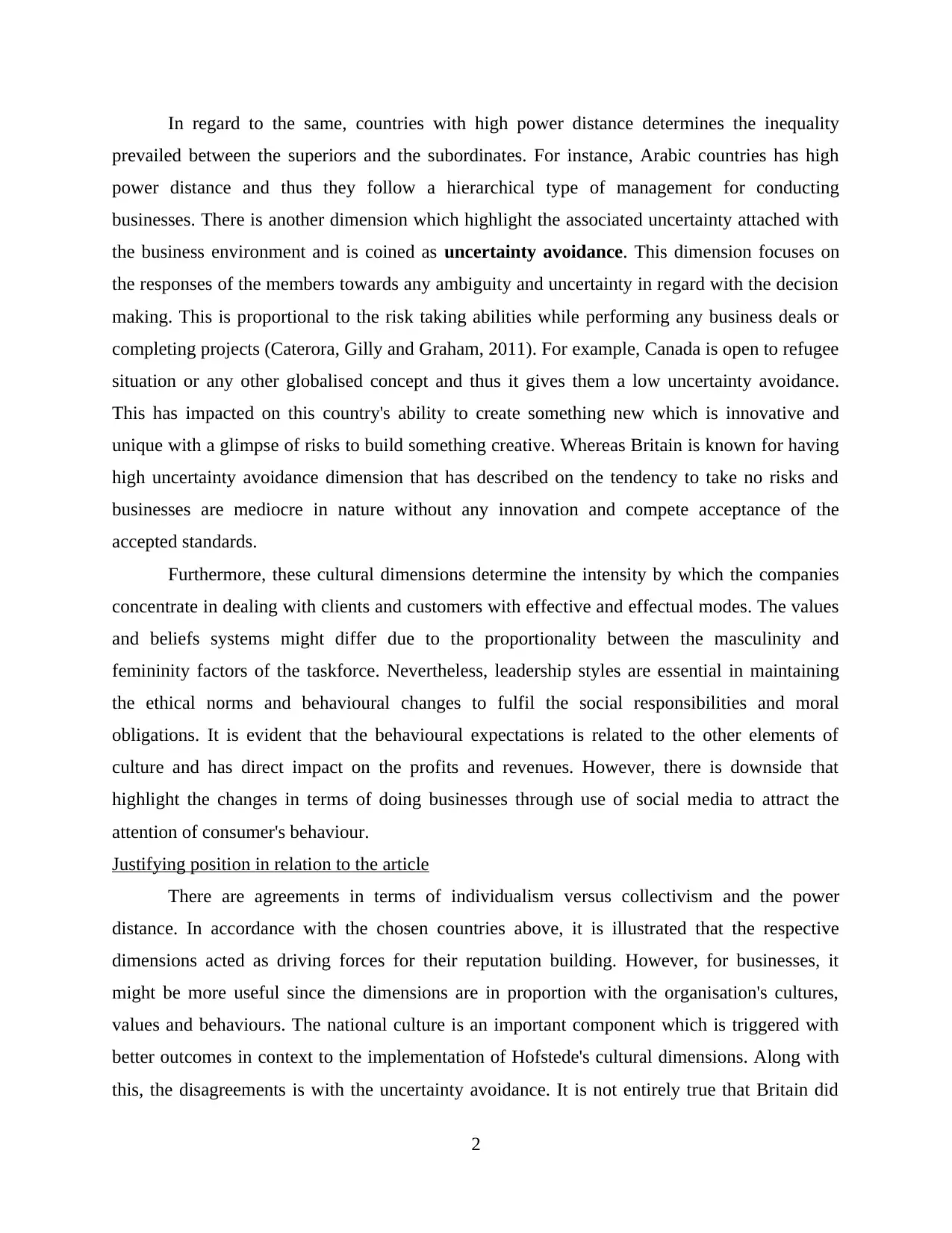
In regard to the same, countries with high power distance determines the inequality
prevailed between the superiors and the subordinates. For instance, Arabic countries has high
power distance and thus they follow a hierarchical type of management for conducting
businesses. There is another dimension which highlight the associated uncertainty attached with
the business environment and is coined as uncertainty avoidance. This dimension focuses on
the responses of the members towards any ambiguity and uncertainty in regard with the decision
making. This is proportional to the risk taking abilities while performing any business deals or
completing projects (Caterora, Gilly and Graham, 2011). For example, Canada is open to refugee
situation or any other globalised concept and thus it gives them a low uncertainty avoidance.
This has impacted on this country's ability to create something new which is innovative and
unique with a glimpse of risks to build something creative. Whereas Britain is known for having
high uncertainty avoidance dimension that has described on the tendency to take no risks and
businesses are mediocre in nature without any innovation and compete acceptance of the
accepted standards.
Furthermore, these cultural dimensions determine the intensity by which the companies
concentrate in dealing with clients and customers with effective and effectual modes. The values
and beliefs systems might differ due to the proportionality between the masculinity and
femininity factors of the taskforce. Nevertheless, leadership styles are essential in maintaining
the ethical norms and behavioural changes to fulfil the social responsibilities and moral
obligations. It is evident that the behavioural expectations is related to the other elements of
culture and has direct impact on the profits and revenues. However, there is downside that
highlight the changes in terms of doing businesses through use of social media to attract the
attention of consumer's behaviour.
Justifying position in relation to the article
There are agreements in terms of individualism versus collectivism and the power
distance. In accordance with the chosen countries above, it is illustrated that the respective
dimensions acted as driving forces for their reputation building. However, for businesses, it
might be more useful since the dimensions are in proportion with the organisation's cultures,
values and behaviours. The national culture is an important component which is triggered with
better outcomes in context to the implementation of Hofstede's cultural dimensions. Along with
this, the disagreements is with the uncertainty avoidance. It is not entirely true that Britain did
2
prevailed between the superiors and the subordinates. For instance, Arabic countries has high
power distance and thus they follow a hierarchical type of management for conducting
businesses. There is another dimension which highlight the associated uncertainty attached with
the business environment and is coined as uncertainty avoidance. This dimension focuses on
the responses of the members towards any ambiguity and uncertainty in regard with the decision
making. This is proportional to the risk taking abilities while performing any business deals or
completing projects (Caterora, Gilly and Graham, 2011). For example, Canada is open to refugee
situation or any other globalised concept and thus it gives them a low uncertainty avoidance.
This has impacted on this country's ability to create something new which is innovative and
unique with a glimpse of risks to build something creative. Whereas Britain is known for having
high uncertainty avoidance dimension that has described on the tendency to take no risks and
businesses are mediocre in nature without any innovation and compete acceptance of the
accepted standards.
Furthermore, these cultural dimensions determine the intensity by which the companies
concentrate in dealing with clients and customers with effective and effectual modes. The values
and beliefs systems might differ due to the proportionality between the masculinity and
femininity factors of the taskforce. Nevertheless, leadership styles are essential in maintaining
the ethical norms and behavioural changes to fulfil the social responsibilities and moral
obligations. It is evident that the behavioural expectations is related to the other elements of
culture and has direct impact on the profits and revenues. However, there is downside that
highlight the changes in terms of doing businesses through use of social media to attract the
attention of consumer's behaviour.
Justifying position in relation to the article
There are agreements in terms of individualism versus collectivism and the power
distance. In accordance with the chosen countries above, it is illustrated that the respective
dimensions acted as driving forces for their reputation building. However, for businesses, it
might be more useful since the dimensions are in proportion with the organisation's cultures,
values and behaviours. The national culture is an important component which is triggered with
better outcomes in context to the implementation of Hofstede's cultural dimensions. Along with
this, the disagreements is with the uncertainty avoidance. It is not entirely true that Britain did
2
Paraphrase This Document
Need a fresh take? Get an instant paraphrase of this document with our AI Paraphraser
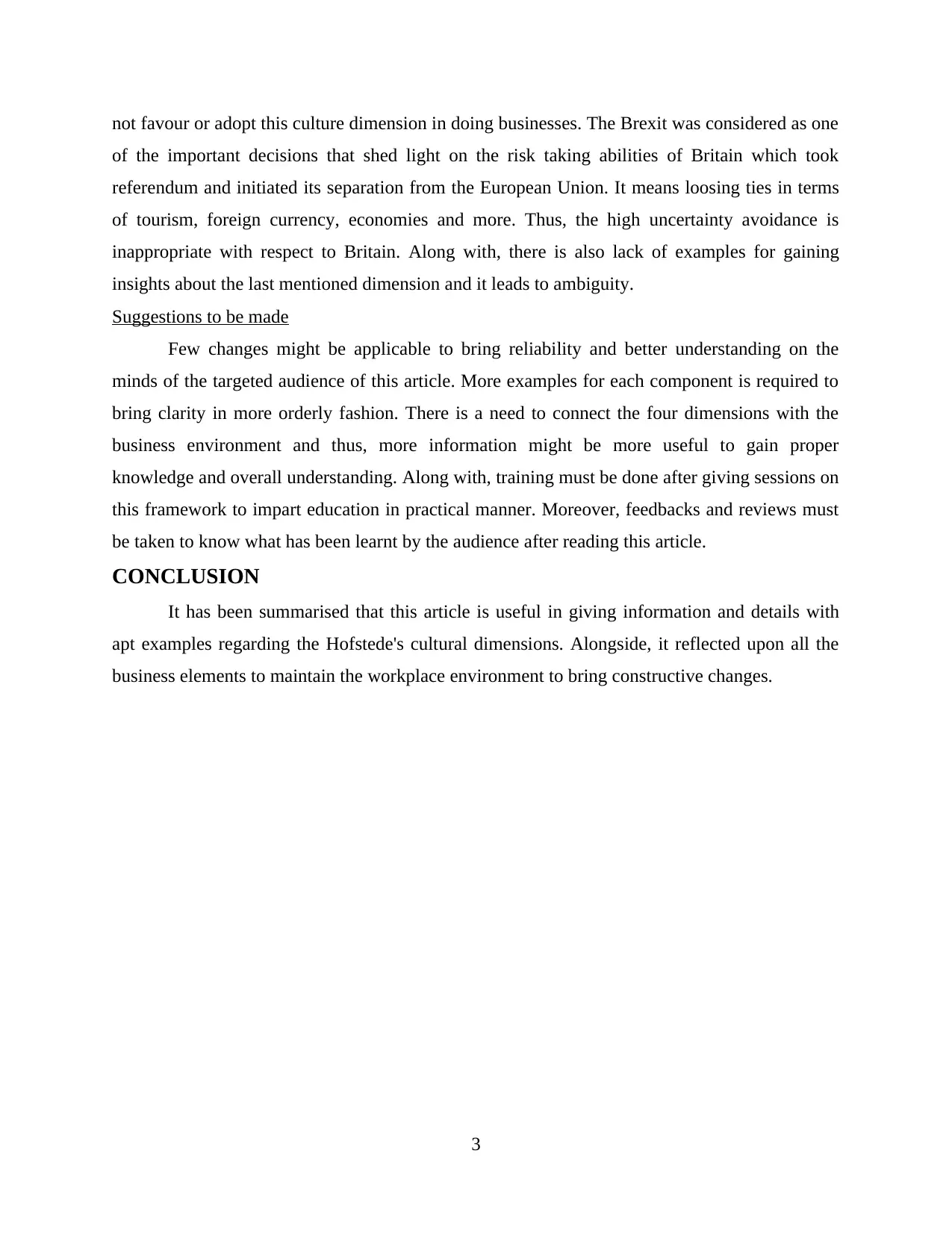
not favour or adopt this culture dimension in doing businesses. The Brexit was considered as one
of the important decisions that shed light on the risk taking abilities of Britain which took
referendum and initiated its separation from the European Union. It means loosing ties in terms
of tourism, foreign currency, economies and more. Thus, the high uncertainty avoidance is
inappropriate with respect to Britain. Along with, there is also lack of examples for gaining
insights about the last mentioned dimension and it leads to ambiguity.
Suggestions to be made
Few changes might be applicable to bring reliability and better understanding on the
minds of the targeted audience of this article. More examples for each component is required to
bring clarity in more orderly fashion. There is a need to connect the four dimensions with the
business environment and thus, more information might be more useful to gain proper
knowledge and overall understanding. Along with, training must be done after giving sessions on
this framework to impart education in practical manner. Moreover, feedbacks and reviews must
be taken to know what has been learnt by the audience after reading this article.
CONCLUSION
It has been summarised that this article is useful in giving information and details with
apt examples regarding the Hofstede's cultural dimensions. Alongside, it reflected upon all the
business elements to maintain the workplace environment to bring constructive changes.
3
of the important decisions that shed light on the risk taking abilities of Britain which took
referendum and initiated its separation from the European Union. It means loosing ties in terms
of tourism, foreign currency, economies and more. Thus, the high uncertainty avoidance is
inappropriate with respect to Britain. Along with, there is also lack of examples for gaining
insights about the last mentioned dimension and it leads to ambiguity.
Suggestions to be made
Few changes might be applicable to bring reliability and better understanding on the
minds of the targeted audience of this article. More examples for each component is required to
bring clarity in more orderly fashion. There is a need to connect the four dimensions with the
business environment and thus, more information might be more useful to gain proper
knowledge and overall understanding. Along with, training must be done after giving sessions on
this framework to impart education in practical manner. Moreover, feedbacks and reviews must
be taken to know what has been learnt by the audience after reading this article.
CONCLUSION
It has been summarised that this article is useful in giving information and details with
apt examples regarding the Hofstede's cultural dimensions. Alongside, it reflected upon all the
business elements to maintain the workplace environment to bring constructive changes.
3
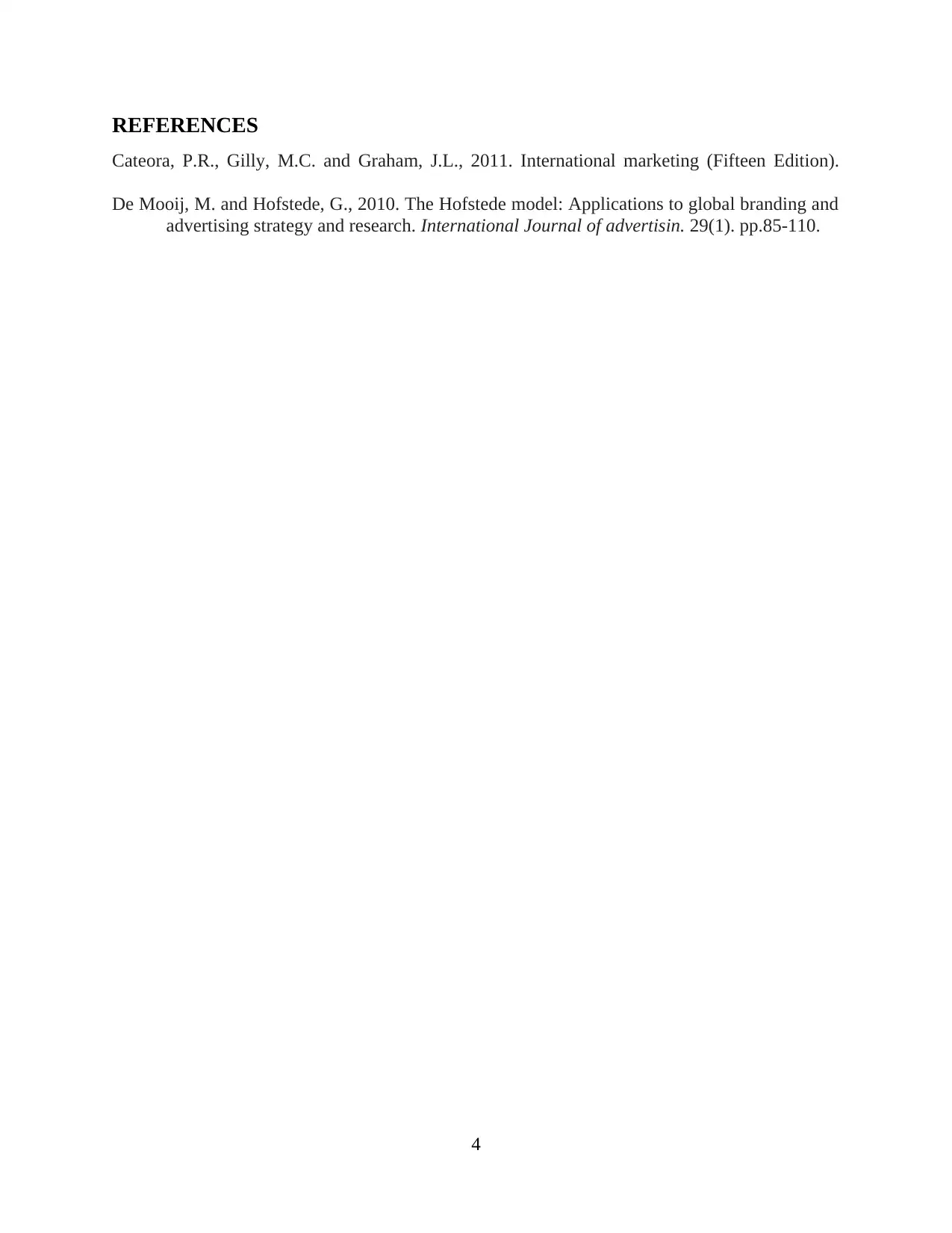
REFERENCES
Cateora, P.R., Gilly, M.C. and Graham, J.L., 2011. International marketing (Fifteen Edition).
De Mooij, M. and Hofstede, G., 2010. The Hofstede model: Applications to global branding and
advertising strategy and research. International Journal of advertisin. 29(1). pp.85-110.
4
Cateora, P.R., Gilly, M.C. and Graham, J.L., 2011. International marketing (Fifteen Edition).
De Mooij, M. and Hofstede, G., 2010. The Hofstede model: Applications to global branding and
advertising strategy and research. International Journal of advertisin. 29(1). pp.85-110.
4
⊘ This is a preview!⊘
Do you want full access?
Subscribe today to unlock all pages.

Trusted by 1+ million students worldwide

5
Paraphrase This Document
Need a fresh take? Get an instant paraphrase of this document with our AI Paraphraser

6

7
⊘ This is a preview!⊘
Do you want full access?
Subscribe today to unlock all pages.

Trusted by 1+ million students worldwide
1 out of 9
Related Documents
Your All-in-One AI-Powered Toolkit for Academic Success.
+13062052269
info@desklib.com
Available 24*7 on WhatsApp / Email
![[object Object]](/_next/static/media/star-bottom.7253800d.svg)
Unlock your academic potential
Copyright © 2020–2025 A2Z Services. All Rights Reserved. Developed and managed by ZUCOL.




